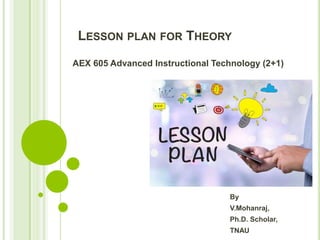
Lesson plan for Theory
- 1. LESSON PLAN FOR THEORY AEX 605 Advanced Instructional Technology (2+1) By V.Mohanraj, Ph.D. Scholar, TNAU
- 3. LESSON PLAN A teacher’s detailed description of the course of instruction for an individual lesson. -- Wikipedia Dictionaries. A lesson plan is a written guide for trainers plans in order to achieve the intended learning outcomes. It provides specific definition and direction on learning objectives, equipment, instructional media material requirements, and conduct of the training. -- Education Dictionaries
- 6. LESSON PLANNING IMPORTANT A newly trained teacher who could be faced with varied unpredictable situation. Teachers and persons who are participating in some kind of training program especially that much includes observation. Teachers who want to reduce over reliance on textbooks and to adapt situations.
- 7. WHAT HAPPENS WHEN A TEACHER HAS NO LESSON PLAN There is over reliance on textbooks. Lesson delivery is not always smooth. There is no smooth transition when another teacher takes over the class. Course materials are underutilized.
- 9. WHAT TO CONSIDER WHEN WRITING A LESSON PLAN A. Know your students B. Know the content C. Know the instructional materials
- 10. 1. Know your students Ability & interest levels Backgrounds Attention spans Ability to work together in groups Prior knowledge and learning experiences Special needs or accommodations Learning preferences
- 11. 2. KNOW THE CONTENT 1. Subject matter that you will be teaching 2. State/school district curriculum guides 3. National/state curriculum standards
- 12. 3. KNOW THE INSTRUCTIONAL MATERIALS Technology, software, audio/visuals, teacher mentors, community resources, equipment, library resources, local guest speakers, etc.
- 13. THREE IMPORTANT LESSON PLAN MODELS ARE The 5E’s Model Engage Explore Explain Elaborate Evaluate
- 14. GAGNE’S NINE EVENTS OF INSTRUCTION
- 15. MADELINE HUNTER'S SEVEN STEP LESSON PLAN MODEL Step 1. Review Step 2. Anticipatory Set Step 3. Objective Step 4. Input and modeling Step 5. Checking understanding Step 6. Guided practice Step 7. Independent practice
- 16. TYPES OF LESSON PLAN-THEORY There are several types of Lesson plan the following: Detailed lesson plan Semi-detailed lesson plan Understanding by Design (UbD)
- 17. 1. DETAILED LESSON PLAN It provides mastery of what to teach, and gives the teacher the confidence when teaching. In this plan, both teacher’s and students’ activities are presented.
- 18. 2. SEMI-DETAILED LESSON PLAN A semi-detailed lesson plan is less intricate than the detailed lesson plan. It is having a general game plan of what you wanted to cover for that subject on that particular day.
- 20. PARTS OF LESSON PLAN There are five parts of detailed and semi-detailed lesson plans: A. Objectives B. Subject matter C. Procedure D. Evaluation E. Assignment
- 21. A. OBJECTIVES The first thing a teacher does is create an objective, a statement of purpose for the whole lesson. An objective statement itself should answer what students will be able to do by the end of the lesson. The objective drives the whole lesson, it is the reason the lesson exists. Care is taken when creating the objective for each day’s lesson, as it will determine the activities the students engage in.
- 22. B. SUBJECT MATTER Subject matter or specific topic includes sources of information, e.g., textbooks and library references.
- 23. The subject matter includes the following: Topic – particular lesson Reference/s – usually from the book and internet websites. Materials – refer to objects or tools that serve as instructional aids for particular subject.
- 24. C. PROCEDURE The procedure is the body of your lesson plan, the ways in which you'll share information with students and the methods you'll use to help them assume a measure of mastery of that material. In detailed lesson plan, the expected routines, lesson proper, activities are presented. Questions and answers are written. In semi-detailed lesson plan has only contains procedures or steps to be used in the lesson proper.
- 25. D. EVALUATION It can take the form of formative test consisting of a 10- item multiple choice questions after the day’s lesson to determine the mastery of learning, e.g., 95% of the class got 100% correct answers.
- 26. E. ASSIGNMENT It includes questions, exercises, and/or a set of practice specified by the teacher. In order to succeed in discussing the assignment for the following day, a teacher give focused/specific questions for students to answer.
- 27. 3. UNDERSTANDING BY DESIGN (UBD) It is a framework for improving student achievement through standards-driven curriculum development, instructional design, assessment and professional development. The emphasis of UbD is on "backward design", the practice of looking at the outcomes in order to design curriculum units, performance assessments, and classroom instruction.
- 29. PARTS OF UNDERSTANDING BY DESIGN (UBD) There are three stages of Understanding by Design or UbD: Stage 1 - Desired results Stage 2 – Assessment Evidence Stage 3 – Learning Plan
- 30. SIMILARITIES AND DIFFERENCES OF THREE LESSON PLANS- THEORY Detailed Semi-detailed UbD Objectives Desired Goals Not included the understandings and essential questions able to show the students their understand the lessons Understandings and essential questions for the students Procedures are detailed from daily routines to lesson proper. Conversations, questions, and answers between the teacher and students. Procedures omits the student activity in the lesson plan Procedures are included in learning plan.
- 31. Evaluation Evaluation is in the learning plan that includes the particular activities Subject Matter Materials and other references are included in the resources Assignment Assignment usually found in the assessment evidence Detailed Semi-detailed UbD
